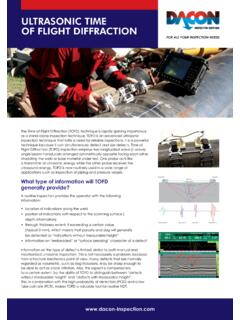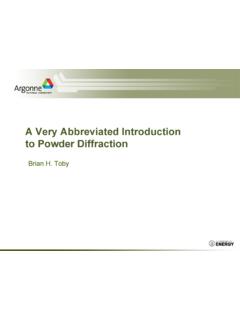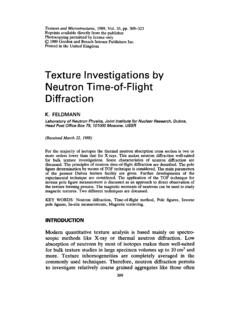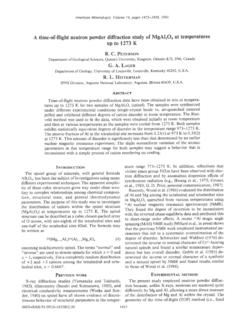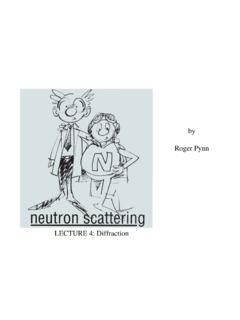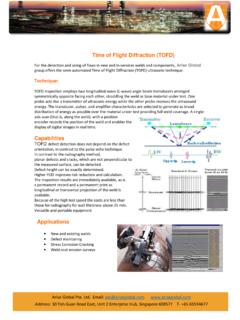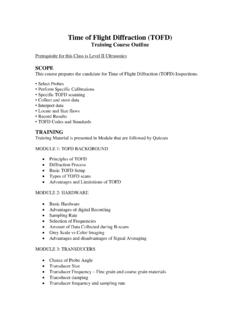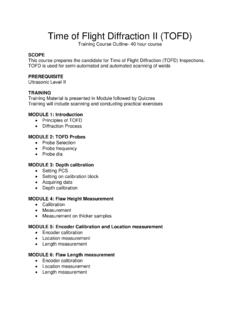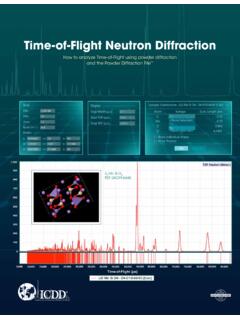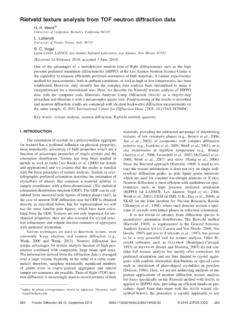Transcription of Ultrasonic Time of Flight Diffraction Technique for Weld ...
1 Research Journal of Applied Sciences, Engineering and Technology 4(24): 5525-5533, 2012 ISSN: 2040-7467 Maxwell Scientific Organization, 2012 Submitted: March 23, 2012 Accepted: April 26, 2012 Published: December 15, 2012 Corresponding Author: K. Manjula, Department of CSE/IT, SRC, SASTRA University, Kumbakonam, India 5525 Ultrasonic time of Flight Diffraction Technique for Weld Defects: A Review 1K. Manjula, 2K. Vijayarekha, 3B. Venkatraman and 1 Durga Karthik 1 Department of CSE/IT, SRC, SASTRA University, Kumbakonam, India 2 Department of EEE, SASTRA University, Thanjavur, India 3 IGCAR, Kalpakkam, India Abstract: To achieve the quality and safety in industrial applications, the damaged products must be detected.
2 To do that NDT is used. In NDT, Ultrasonic time -of- Flight Diffraction is a well-known Technique for detecting the size and location of the defects. Nowadays the time of Flight Diffraction (ToFD) is used for inspecting the materials during production than that of radiography and other Ultrasonic NDT procedures. ToFD Technique can be used into many different ways. This study gives a review of various Ultrasonic ToFD techniques for welding defects and aims at the usage of it. Keywords: i-ToFD, NDT, s-ToFD, ToFD, UT, weld, weld defects INTRODUCTION The concept of detecting flaws without destroying the material is called Non-Destructive Testing.
3 Without making any damage, the characteristics of the component, material, or system can also be examined using this NDT techniques. NDT can save both money and time in their applications. Basically the highly-valuable Technique NDT comprises of: Non-Destructive Examination Nondestructive Inspection Nondestructive Evaluation It is a tool in engineering, medicine and art (Wikipedia, 2012). Various Non-Destructive Testing and Evaluation methods are Mgnetic-Particle testing, Liquid Penetrant testing, Eddy-current testing, Visual testing, Radiographic testing, Ultrasonic testing, Thermo graphic testing, Electromagnetic testing, Low coherence interferometry testing and Optical testing methods.
4 These methods are used to detect and evaluate internal discontinuities or leaks in a system. One of the areas wherein NDE is frequently used is Flaw Detection. It is in great demand in many industrial applications. Welding is a process of joining two materials using metals and thermoplastic through localized coalescence resulting from a suitable combination of pressure, temperature and metallurgical conditions. Based on the combination of pressure and temperature, , from a high temperature with no pressure to a low temperature with high pressure, a grand range of welding processes have been developed.
5 Based on the energy sources, welding processes are basically divided into three types and they are Arc welding, MIG welding and TIC welding. In industrial activities such as manufacturing, weld is used to join more than one metal surfaces or pieces. Since these weld connections may have fatigue and loads during the lifetime of the product, there is a chance that they may fail if it is not created properly (Wikipedia, 2012). To weld, the energy sources used for welding may be a gas flame, an electric arc, a laser, an electron beam, friction and ultrasound.
6 Crack, Slag, Undercut, Porosity, LF, LP, Overlap, Excess Convexity, Excess Concavity, Excess weld Reinforcement and etc., are known as defects of weld. The typical welding defects could create a structure to break or a pipeline to rupture. The refined weld or welded material must be inspected for weld defects. These are all the important factors to check whether a welding work is to be accepted or rejected based on which, the quality of the weld is to be determined.
7 Welds may be tested by NDT techniques such as industrial radiography or industrial CT scanning using X-rays or -rays, UT, etc., In a proper weld, these tests would indicate a lack of cracks in the radiograph, show clear passage of sound through the weld and back, or indicate a clear surface without penetrant captured in cracks (Absolute, 2011). Vibrations of Sound waves are characterized by their frequencies. Based on their frequencies the sound Res. J. Appl. Sci. Eng. Technol., 4(24): 5525-5533, 2012 5526 wave is divided into three.
8 The frequencies of sound waves which are less than 20 Hz are known as Infrasound or Infrasonic waves. If the frequency lies between 20 Hz to 20 KHz then the sound wave is called Audible wave. Otherwise, the sound wave is called Ultrasound or Ultrasonic wave. Now we can discuss about Ultrasonic Testing and then ToFD for detecting flaws. Introduction to Ultrasonic testing: In Ultrasonic Testing, very short Ultrasonic pulse-waves with center frequencies ranging from to 15 MHz and rarely upto 50 MHz are launched into materials to detect interier flaws or to find the characteristics of materials.
9 It is used to find the thickness of the test material. Ultrasonic testing is done on steel, other metals and alloys, concrete, wood and composites with less resolution. It is a form of NDT used in many industries such as aeronautic, automotive and other sectors also. If there is a change in test material, then the Ultrasonic waves will be reflected from the material. This principle is used in NDT. Since the flaws can be detected without destroying the material, It is called as NDT.
10 In UT, an ultrasound transducer connected to an instrument is launched over the material being inspected. The transducer is separated from the material by a couplant. To receive the ultrasound waveform, two methods namely Reflection and Attenuation are used. In Pulse-Echo mode or Reflection mode, the transducer performs both the sending and the receiving of the pulsed waves as the "sound" is reflected back to the device (Wikipedia, 2012). Reflected ultrasound comes from an interface, such as the back wall of the material or from a defect within the material.

